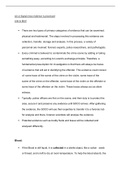AC1.3 Explain how evidence is processed
Link to Brief
There are two types of primary categories of evidence that can be examined:
physical and testimonial. The steps involved in processing this evidence are
collection, transfer, storage and analysis. In this process, a variety of
personnel are involved: forensic experts, police researchers, and pathologists.
Every criminal is believed to contaminate the crime scene by adding or taking
something away, according to Locard’s exchange principle. Therefore, a
fundamental presumption for investigators is that there will always be traces
of evidence that will aid in identifying the offender. This evidence could consist
of: some trace of the scene of the crime on the victim, some trace of the
scene of the crime on the offender, some trace of the victim on the offender or
some trace of the offender on the victim. These traces always act as silent
witness.
Typically, police officers are first on the scene, and their duty is to protect the
area, secure it and preserve any evidence until SOCO arrives. After gathering
the evidence, the SOCO will use their expertise to transfer it to a forensic lab
for analysis and there, forensic scientists will analyse the evidence.
Potential evidence such as bodily fluids and tissue will be collected and
analysed differently.
Blood:
If the Blood is still liquid, it is collected in a sterile object, like a cotton swab
or thread, and is left to dry at room temperature. To help the blood absorb, the
, sterile substance is gently rolled over the area. The blood-containing material
will be collected and put in a sterile, sealed bag if the blood stain is dry.
Clothing articles are then placed in an evidence bag while keeping them
unfolded. It will then be transferred to a lab for a forensic scientist to evaluate
it within 2 hours. The blood will be examined for DNA evidence, blood type
and toxicology. In relation to the brief, the police would have collected the
droplets of blood on Lee’s pillow using these methods of collection.
Semen:
Stains are collected by first allowing the item of clothes or bedding they were
detected on to dry. They become off-white to pale yellow in colour when dried.
The stains are then transferred to the lab for a forensic analysis after being
collected and packed in a paper bag, sealed and labelled. To find out if there
is sperm in the stain, DNA analysis is the first step. Sperm contain a
significant amount of DNA, which may be used to identify a suspect. Once the
presence of sperm has been established, a further examination combining
general staining and bright field microscopy is conducted.
An example of this is the case of Ronald Cotton. In 1984, Ronald Cotton was
identified from a sketch by Jennifer Thompson-Cannino as the man who
broke into her apartment and raped her - He was convicted of the rape and
sentenced to life in prison. 10 years later, DNA revealed that Cotton was not a
match to the semen samples however, they did match Bobby Poole, a
convict, who had told an inmate that he committed the crime.




